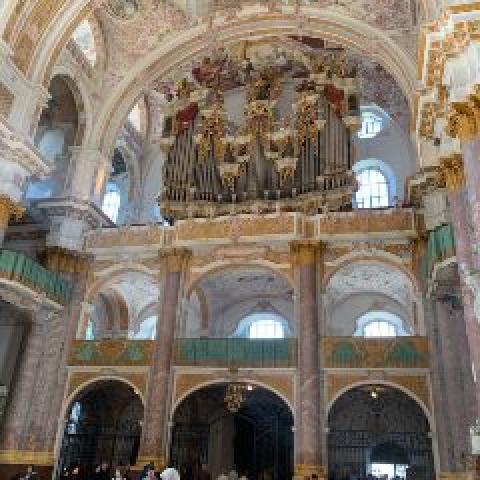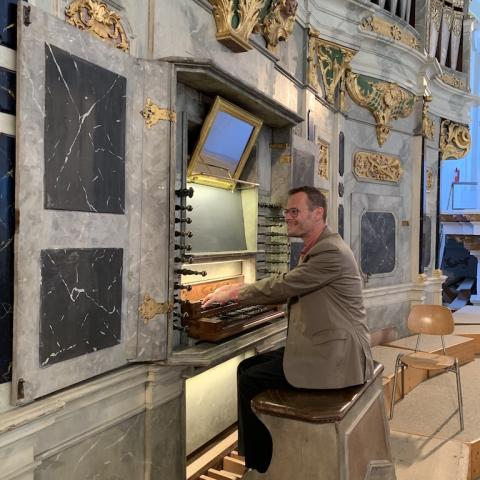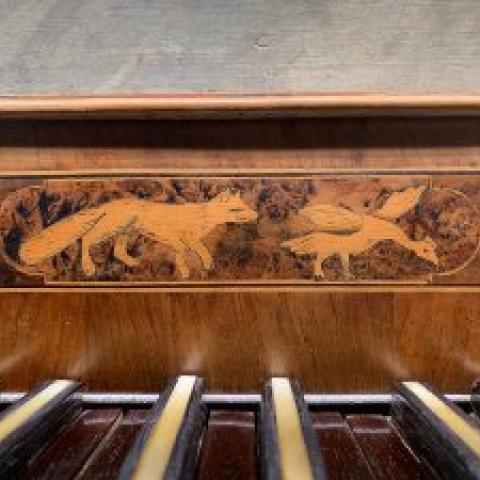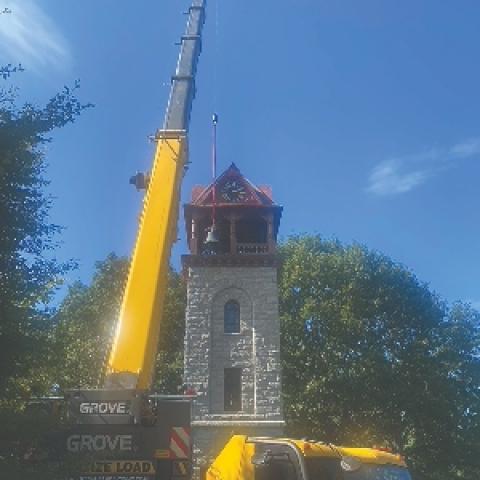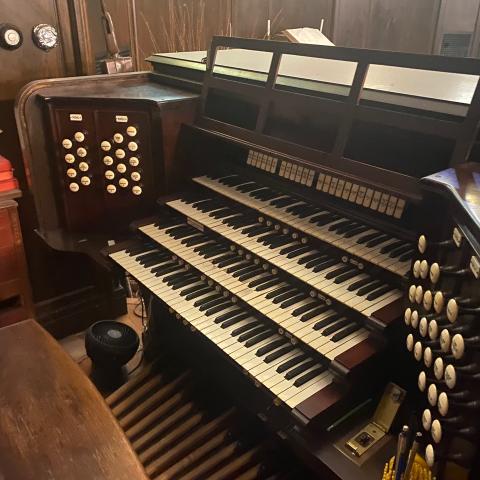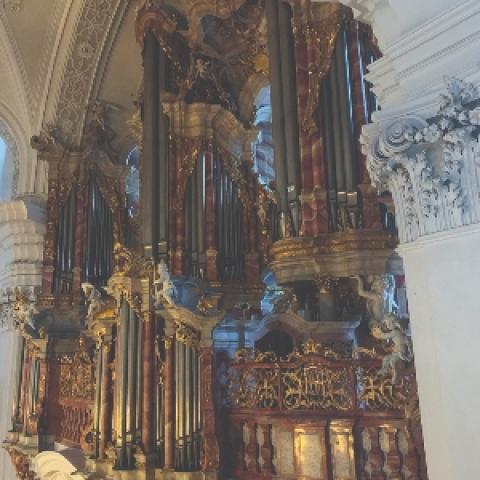
Breathtaking
My father was, among many other things, an ardent and slightly kooky baseball fan. He grew up in Cincinnati watching the Reds at Crosley Field and started a lifelong relationship with the Boston Red Sox when he was in seminary in Cambridge, Massachusetts. I was eleven years old in 1967, the year of the Impossible Dream, when the Red Sox won the American league pennant behind the bat and fielding of Carl Yastrzemski. I think it was that summer that Dad took me to Fenway Park for the first time.
I will never forget my glimpse of all that beautiful green grass as we entered the stands from the scrum in the tunnels beneath. After watching dozens of games on black-and-white television it was breathtaking, and as I write that word, I imagine that I can feel the gasp. It took my breath away. A couple days ago, I was listening to a story on NPR about Iranian women being allowed to watch a live soccer match for the first time in forty years. (Google “Iranian women soccer,” and you will find a slew of stories.) One woman interviewed brought a tear to my eye when she mentioned “all that green grass.” I knew just what she was feeling, except that I have always taken my access to major league sports for granted.
I had the same sort of feeling the first time I heard the Boston Symphony Orchestra live in Symphony Hall. I had never heard anything like those double basses. My breath was taken away again when I stepped into a gallery at the Museum of Modern Art in New York and saw Vincent van Gogh’s Starry Night in real time. It looks great on a coffee mug or a t-shirt, but that is not the same.
A couple weeks ago I spent a week in Germany visiting an organbuilder’s workshop to discuss a future project. An American colleague was also visiting to give first lessons in voicing organ pipes to a bright young apprentice. And while I was there, I visited three historic organs. Two were iconic eighteenth-century masterpieces, gleaming away in their natural habitat. The third was a beauty built in Boston in 1930 for a church in Passaic, New Jersey. What are you doing in Germany?
A glass of wine, Herr Gabler?
The Basilica of Saint Martin is perched on a hill in eponymous Weingarten, the principal town in a region known for growing grapes and producing wine. I had my first glimpse of its towers as I turned a corner passing Burger King. It is a town of about 24,000 people with a long and complicated history of changes of government and processions of Lord Mayors and Abbots. The exterior of the huge building is simple enough, and it is surrounded by the dormitory-like buildings of what was one of the largest monasteries in Germany.
I first saw photos of the organ built by Joseph Gabler when I was a kid, most likely after that first baseball game because my organ lessons started when I was twelve. Visually, it is at the top of the list of all-time greats, on a par with and wildly different from the Müller organ at Haarlem, you know, the red one with the lions. Enormous organ cases decorated with faux-marble swirl around six huge round windows, everything festooned with putti, moldings, carvings, and virile statues to Rococo extremes. I entered the Basilica of Saint Martin from the west end, under the organ, so my first view of the place was down the three-hundred-foot nave, across a fantasyland of decoration. The arched ceiling, nearly a hundred feet up, is adorned with murals in which painted drapery crosses borders to become real drapery.
When I turned around to look at the organ for the first time, I had two quick impressions. In spite of the 32′ façade pipes, it is up so high that it does not look very big, and its magnificent gaudiness cannot possibly be captured in a photograph. There is so much going on visually that I could not take my eyes off it. It is when you climb the many stairs (I forgot to count) to the organ loft that you find out how big it is. You can hardly see the top of the organ. The biggest façade pipe is 32′ DDDD (the two largest are inside the cases). The loft must be fifty feet across, and you could imagine that there are three or four independent organs up there until you realize that the console is up six steps on a platform that allows tracker action to run every which way, and the floor boards between the base of the console platform and the two cases on the gallery rail have iron rings so they can be lifted to access the mechanics.
I visited Weingarten with the three colleagues from the workshop. Stephan Debeur, organist at the abbey, had only limited time coinciding with my visit, so he invited us to join him at the organ while he played for Mass on Friday evening. The steps to and from the organ console were especially squeaky, making me nervous about distracting the worship, but Stephan assured us that he regularly had visitors while playing, and because of the size of the place, it was not an issue. In the lapses between playing, he led us around, opening access doors so we could see interior pipes and action. He kept his ears on the action downstairs and darted back to the console at appropriate moments. I was amused as he played the role of cantor, braying without amplification down the length of the immense church while accompanying himself on that spectacular organ.
He made a point of demonstrating the Vox Humana, an iconic stop in an iconic organ, a stop of such beauty that a legend grew around it. Joseph Gabler experimented with countless combinations of metal and wood, striving to build the pipes that would perfectly imitate the human voice and failing frequently to his disappointment. The legend has him approaching Satan to exchange his soul for the perfect piece of metal, and that idyllic voice was born. Stephan played “Ich ruf’ zu dir” from J. S. Bach’s Orgelbüchlein (#40), alternating the solo voice up and down by octaves in subsequent lines. Gorgeous.
The organ has many singular features. Every façade pipe is a speaking pipe, even the teeny ones lofted above the high center window. Gabler had planned to have an entire division in that location but settled for running long tubes to conduct wind to those pipes from a windchest far below. There is a stop called La Force (The Power), which plays forty-nine pipes simultaneously on low C of the pedalboard. I was sorry not to hear it, as it is apparently not conducive for use in a simple evening Mass. I guess I will have to go back.
There is a voice in one of the Positiv cases with twenty pipes of solid ivory. Take a look at your lathe, remove the motor, and pump the thing with a foot lever, and try to make an ivory organ pipe without chipping it. And while you are at it, note that the massive drawknobs and their square shanks are also solid ivory. There is elaborate marquetry everywhere you look, on banisters, newels, and console panels. There is hardly a square inch that lacks added ornamentation.
Every time I hear an instrument built in another age, I am struck by the timelessness of the sound of a pipe organ. The organ at Weingarten predates American Guild of Organists console standards by more than 150 years, and it is an awkward sit at first whack. But Stephan ably demonstrated that a modern organist can easily play a modern Mass, changing stops like a conjurer, sending beautifully balanced voices across the immense space. Perched on that six-step platform, he has a spectacular view to the altar, surrounded by mammoth organ cases. It is thought to be the first pipe organ built with a detached console.
When Gabler completed the organ in 1750, the delighted monks presented him with a bonus—enough wine to fill the largest pipe. Assuming that 32′ DDDD has a diameter of twenty inches and dusting off my π, that is about 22,600 cubic inches, which is almost ninety-eight gallons. A standard pour for a glass of wine is five ounces. Herr Gabler could entertain a lot of friends with 2,500 five-ounce glasses.1
Follow the Fox to Munich.
When I asked my friend Stephen Tharp which organs stand out in the neighborhood I was visiting, he all but blurted out Fürstenfeld. The organ in the Fürstenfeld Kloster in Fürstenfeldbruck was completed by Johann Georg Fux in 1736. The church, though smaller than that in Weingarten, is still immense, and sports the same degree of fantastic opulent decoration. There are side altars with spiraling columns in every bay, angels with sunbursts, carvings, and murals everywhere. Once again, the organ is placed so high in the church that it looks small at first. But though it has fewer than thirty stops, it has a 32′ façade. The tallest pipes are mounted on the impost that is well out of reach from the floor. I guess the organ is over forty-five feet tall.
With Stephen’s help, I met the organist Christoph Hauser after Mass on Sunday morning, so I attended Mass to hear the organ well from the floor. It was dazzling. Christoph’s playing was colorful, thoughtful, rhythmic, and inspirational. It was all improvised excepting the hymns and congregational responses, and that ancient organ filled the room with the liveliest tones, both delicate and charming, and full ablaze.
After Mass, I returned the hymnal to the rack and wandered about keeping my eyes on the rear of the room, assuming that Christoph would appear there. A few moments later, I noticed a dapper gent at the front of the room, looking exactly like an organist (you bet I was profiling). Turns out that the stairs start in a sacristy next to the chancel. And such stairs. Once again, I forgot to count, but this organ is in a second balcony, and there were plenty of them. We passed the antique mechanism of the tower clock, the size of a small car with counterweights as big as oil drums hanging from cables high above. The stairs changed from stone to wood, the stairwell grew narrower, and my tuner’s knees along with all they support was barely a match for the thirty-something spry organist I was chasing. We arrived into a gallery that spanned the length of the room, passing through narrow arches at each bay, until we reached the organ. The organ loft is about ten steps down from the gallery allowing a grand view of the side of the organ case, but it was not until I got down those stairs to stand on the same floor as the organ that I could appreciate its size. The 32′ façade pipes are topped by ornate crowns laden with putti, carvings, and more sunbursts, and are mounted on an impost that is well out of reach.
If Weingarten has the oldest detached console, does Fürstenfeld have the tallest two-manual organ?
Speaking of AGO standards, the Fux organ has “short and broken” bass octaves. Both keyboards and the pedalboard are missing the lowest C#, D#, F#, and G#. What looks like E is actually C. What looks like passing from F# to G is actually D to G. Christoph agreed that it took some adjustment, and now that he is used to it, he has to think twice when moving to more usual keyboards. After lots of digging, he determined that Bach’s Dorian Toccata is the only large piece by Bach with a big pedal part that he can play on the organ. I invite and encourage you to type “Hauser Fux Dorian Toccata” into your YouTube search bar. Hang on to your hats: it is a thrilling ride.
Mr. Skinner goes to Ingelheim.
In 2008, the Organ Clearing House sold Skinner Organ Company’s Opus 823 (1930) to the Saalkirche in Ingelheim am Rhein, Germany. The church’s organist Carsten Lenz had long intended to import a Skinner organ to Germany, and this exciting transaction happened after four years of conversations, lots of touring around the eastern United States, and a frightening heap of paperwork. The organ was shipped to Klais Orgelbau in Bonn where it was releathered, renovated, and reconfigured under the supervision and with the advice of Skinner experts Sean O’Donnell and Nelson Barden.
The church in Passaic, New Jersey, where the organ was originally installed, had been purchased by a new congregation, and the decorated façade pipes were to stay in place, so Klais produced a new case of contemporary design including new pipes to replace the original speaking façade pipes from 16′ and 8′ Diapasons. The organ was originally placed in deep chambers in a large room with plaster walls, carpeting, and lovely pew cushions. The new setting has the organ placed in a new shallow case in a high balcony on the center axis of a brick and stone room. The thoughtful installation included placing the large wood pedal pipes in front of the exposed Great division to control the egress of tone. Even with that precaution, it was still necessary to hang heavy sheets of felt in front of the Great to balance the tone in the lively acoustics.
I was delighted to see the shellac, ink lettering, distinctive racking styles, and beefy expression shutters we know so well from long experience with Skinner organs. I was delighted to hear the distinctive tones of Mr. Skinner’s specialty voices so far from home. And I was delighted to hear Carsten describe how German audiences have responded to the unique sounds of the Skinner organ.
We have heard criticism about exporting American organs, expressing the feeling that they should stay at home. I have two thoughts to share. Skinner #823, like many of the instruments we have shipped overseas, was on the market for five years before the church in Ingelheim purchased it. Better to be sent overseas than never to be heard again. And for the last seventy years, American organists and organbuilders have been influenced by European traditions. Reciprocity is a good thing. Germany has a five-hundred-year history of building pipe organs, but no one in Germany has ever built a Skinner organ. There is nothing else like it. Seems we can teach them a thing or two, especially, according to Carsten, when American organists come to play!
§
It is impossible to fully describe the experience of visiting a single fine pipe organ, writing a paragraph about each individual voice or chorus, describing the feel of different keyboards, the intricacies of design, the quirks, the chirps, and the foibles. In the mid-eighteenth century when the Weingarten and Fürstenfeldbruck organs were built, there was no other machine made by humans quite as complicated as a pipe organ. With more than seven-thousand pipes, the Weingarten organ is large by modern standards, and its console placement is visionary.
Returning to AGO standards, or what we are used to in organs, the twenty-nine-stop Fürstenfeld organ has only one reed, 16′ Trompas2 in the Pedal (prominently displayed in Christoph Hauser’s recording of the Dorian Toccata). How can you play an organ with no manual reeds? Shut up and sing, that’s how. And by the way, most of the mixtures include tierces, and full organ sure sounds as though there are manual reeds.
I shared my thrill and thrall on Facebook after each of these visits and received a comment about Weingarten that stood out. “I’ve always thought that organ was a little soft in the church. I’m sure Gabler did his best.” Oof. Herr Gabler’s worst is far better than the best of most organbuilders, even after 2,500 glasses of wine.
Notes
1. You can see the specification of the Gabler organ at Weingartern here: https://en.wikipedia.org/wiki/Organ_of_the_Basilica_of_St._Martin_(Wein….
2. Yes, it really is 16′ Trompas. You can see the specifications of the Fux organ at Fürstenfeldbruck here: https://de.wikipedia.org/wiki/Orgeln_der_Klosterkirche_Fürstenfeld.

